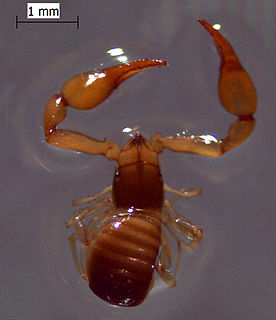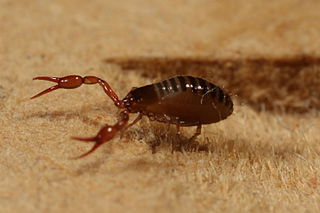Related Research Articles

A pseudoscorpion, also known as a false scorpion or book scorpion, is an arachnid belonging to the order Pseudoscorpiones, also known as Pseudoscorpionida or Chelonethida.

Joseph Conrad Chamberlin was an American arachnologist who studied mainly pseudoscorpions. A native of Utah, he studied primarily at Stanford University while working most of his career in Oregon for the U.S. Department of Agriculture. Several species are named in his honor.

Chthoniidae is a family of pseudoscorpions within the superfamily Chthonioidea. The family contains more than 600 species in about 30 genera. Three fossil species are known from Baltic and Dominican amber.
Tridenchthonius is a genus of pseudoscorpions in the family Tridenchthoniidae. There are about 16 described species in Tridenchthonius.
Cryptoditha elegans is a species of pseudoscorpions. It is found in Brazil. The type locality is Passa Quatro, Minais Gerais.
Olpiidae is a family of pseudoscorpions in the superfamily Garypoidea. It contains the following genera:
Horus is a genus of pseudoscorpions in the family Olpiidae, containing the following species:

Hans Henderickx was a Belgian entomologist specializing in Invertebrates born in Mol, Belgium.

Neobisium is a genus of pseudoscorpions in the family Neobisiidae.
Garypus is a genus of pseudoscorpions in the family Garypidae. There are at least 20 described species in Garypus.

Neobisium sylvaticum is a species of pseudoscorpions in the Neobisiidae family. It is found throughout Europe with the exception of the Benelux union, the Nordic countries, and the British Isles. The type locality is Frauenholz in Regensburg, Bavaria, Germany.
Syarinus is a genus of pseudoscorpions in the family Syarinidae. There are about six described species in Syarinus.
Hesperochernes is a genus of pseudoscorpions in the family of Chernetidae.

Neobisiinae is a subfamily of pseudoscorpions in the family Neobisiidae.

Neobisium carcinoides is a species of pseudoscorpions in the Neobisiidae family. It is found throughout Europe with the exception of Greece, Belarus, and Russia. The type locality is 7 km south of Strasbourg, in the Bas-Rhin department, Alsace, France.
Neobisium beroni is a species of pseudoscorpions in the Neobisiidae family. It has only been found in Bulgaria. Its type locality is cave Svinskata peshtera, Lakatnik, Iskur River gorge, Sofiya, Bulgaria.
Neobisium noricum is a species of pseudoscorpions in the Neobisiidae family. It has only been found in Austria, and once in Hungary. The type locality is Hohentauern in Styria, Austria.
Chitrella is a genus of pseudoscorpions in the family of Syarinidae.
Chitrella regina is a species of pseudoscorpions in the family Syarinidae.
References
- ↑ Chamberlin, Joseph Conrad (1930). A synoptic classification of the false scorpions or chela-spinners, with a report on a cosmopolitan collection of the same. Part II. The Diplosphyronida (Arachnida-Chelonethida).
- ↑ "Neobisium incertum". Integrated Taxonomic Information System . Retrieved 5 July 2018.
- ↑ Harvey, Mark (2011). "Neobisium (Neobisium) incertum Chamberlin, 1930". Pseudoscorpions of the World 1.2. Western Australian Museum.